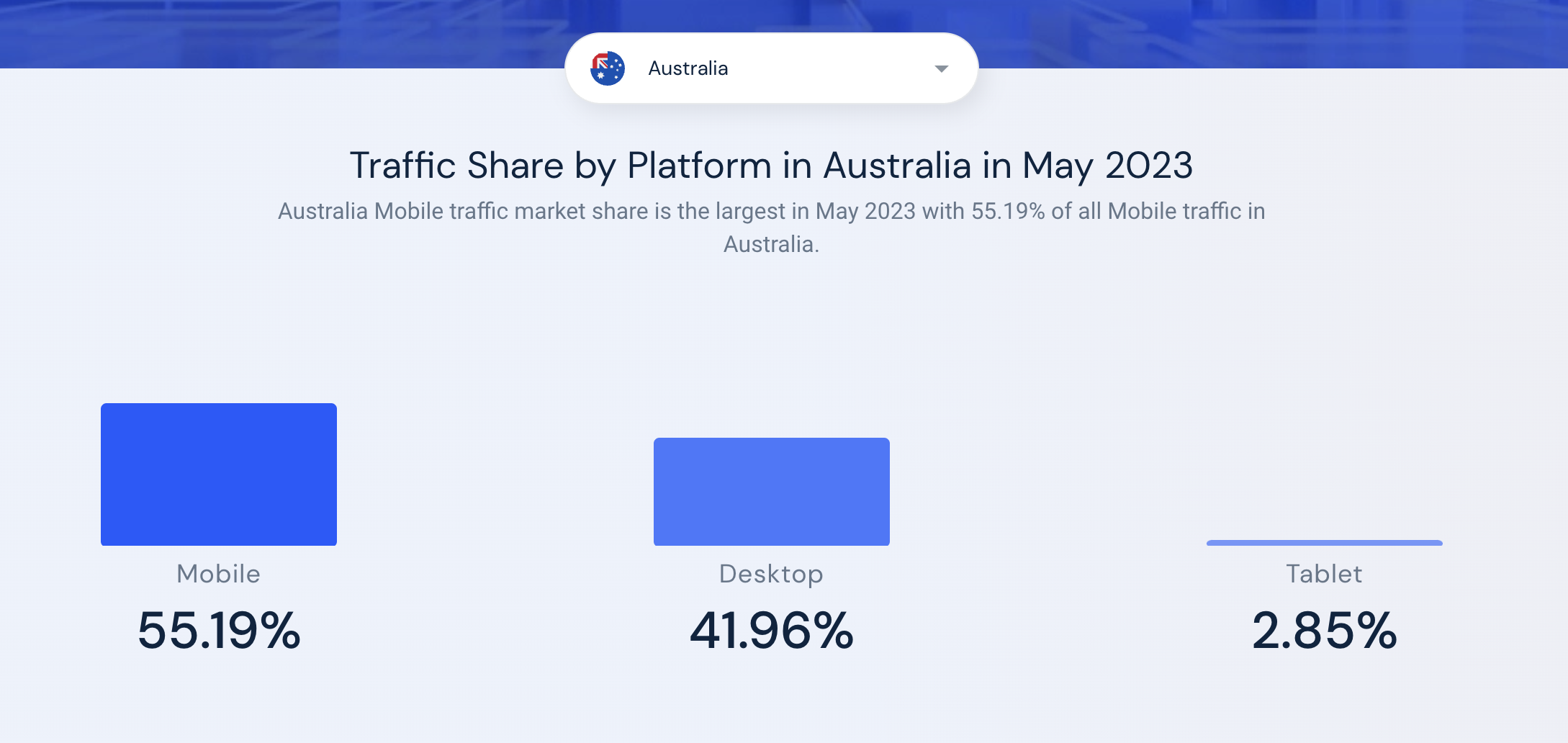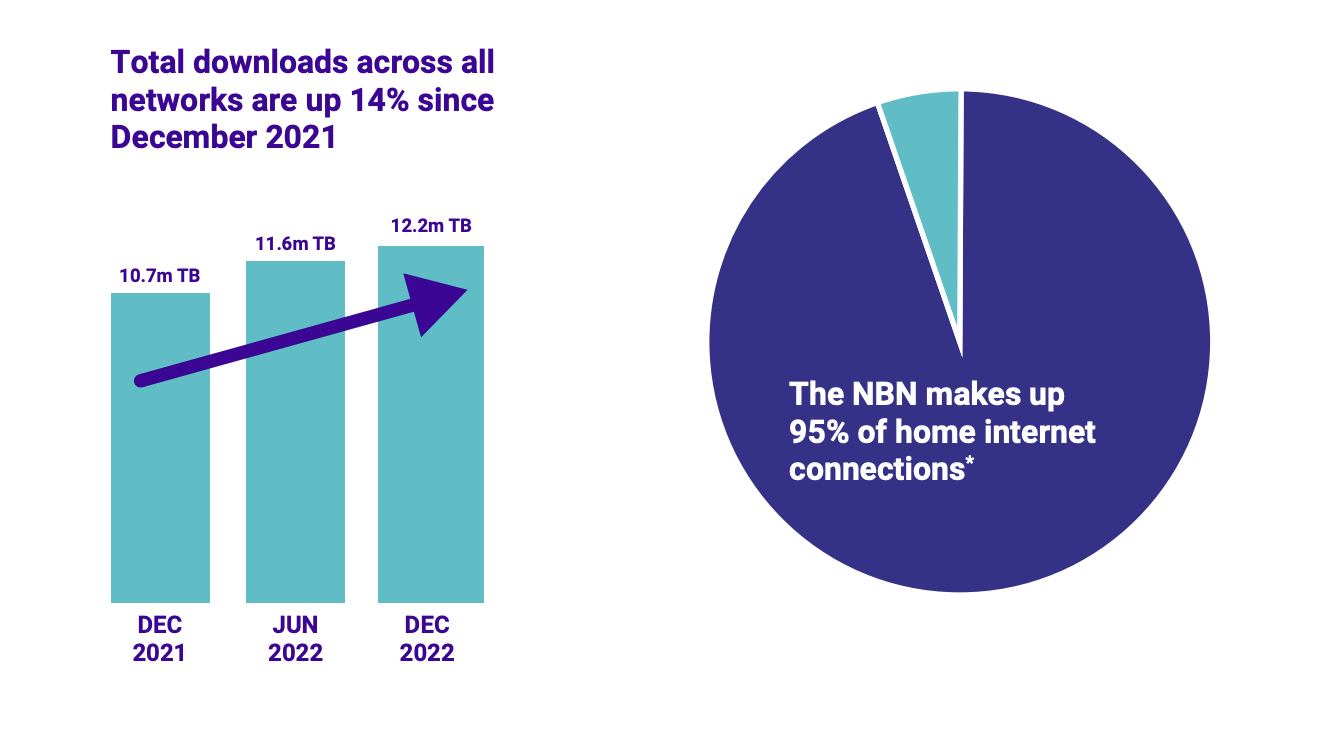
- Red Search
- Resources
- Mobile Data Statistics
Australian Mobile Data Usage Statistics 2023
-
 Daniel Law
Daniel Law
Mobile phones have come a long way from massive brick-sized devices to handheld smartphones with data storage larger than the Apollo 11 Guidance Computer. That thing has only 32KB of RAM!
Likewise, we expect mobile data usage to reach the moon as breakthroughs in 5G, IoT, and everyday content strengthen how smartphones augment our lives. Currently, there are more smartphones and mobile connections than actual people in Australia!
But that’s not all.
We rounded up the most burning statistics and found some interesting results. Here are the latest Australian mobile data consumption facts and figures in 2023.
Read on and discover insights that can supercharge your business and expand to a wider reach.
Australian Mobile Data Usage: In Numbers
There were 32.71 million mobile connections in Australia in early 2023. To put it into perspective, that’s 124.3% compared to the country’s total population!
Dissecting that information reveals that 92.2% of Australians use a smartphone on a daily basis. Moreover, 85.4% of those access the internet using a smartphone—beating laptops and desktops at only 77.4%.
The increasing demand for data usage fueled Australia’s internet connection speed. In 2023, the median mobile data download speed reached 86.01 Mbps, a tad higher than the fixed data connection speed of 53.06 Mbps.
In terms of market share, the latest data reveals that Australia’s mobile traffic is the largest in May 2023, reaching a record 55.19% market share and lapping desktop traffic with only 41.96%.

Internet Penetration in Australia
We looked at three different studies on Australia’s total number of internet users.
Here’s what sources say:
- CIA World Factbook reported approximately 24.96 million Australians are using the internet (2021)
- International Telecommunication Union (ITU) reported a 96% penetration of 23.96 million users. This shows consistency with the CIA’s findings.
- Internet World Stats indicated that there are 23.391 million internet users in Australia. That’s roughly 89% of the country’s population.
More users mean more demand and volume, right? This is what we found out:
Mobile Data Download
The latest data from Australian Competition & Consumer Commission reported that Australian internet users downloaded over 12.2 million Terabytes (TB) across broadband and mobile data in December 2022.
Furthermore, NBN connections account for 83% of mobile data volume, approximately 10.1 million TB!

Non-NBN services reported the following data volume downloads:
- Average Volume for Non-NBN Stationary ISPs: 347.75 GB per month
- HFC users: 288 GB/month
- Fibre internet subscribers: 479 GB/month
- DSL consumers: 435 GB/month
- Satellite users: 189 GB/month
Here’s how much Australians consume mobile data on different internet services:
- Home wireless broadband: 283 GB/month
- Prepaid mobile: 7.2 GB/month
- Post-paid mobile: 14.5 GB/month
- Mobile broadband: 11.5 GB/month
Considering that most Australian households use stationary internet for home Wi-Fi, it’s safe to say that mobile phones are driving internet consumption to the moon!
But where do we spend all these data?
Mobile Data Usage Statistics
Fresh statistics from the online library DataReportal found that Aussies spend roughly 4 hours and 54 minutes using smartphones daily. Moreover, 2 hours and 59 minutes, or 51% of that time, is spent browsing the web.
Mobile app stores are also blasted with daily downloads, with up to 790 million reported mobile app downloads in 2023 across all platforms (Apple, Android, etc).
Mobile internet traffic is something all businesses and marketing agencies should take seriously. Apparently, mobile traffic accounts for 42.58% of the total web traffic. That’s a 6.8% YOY increase!
Here’s a breakdown of mobile web traffic by mobile OS:
- Android devices: 41.08% of mobile web traffic (-1.7% YOY)
- Apple devices: 57.99% of mobile web traffic (+1.8% YOY)
- Samsung OS devices: 0.82% of mobile web traffic (-32.7% YOY)
- Other OS devices: 0.10% of mobile web traffic
Mobile Data Usage Breakdown: By Activity
Mobile traffic is taking the Aussie digital world by storm. But understanding where this traffic goes is vital in developing a mobile SEO campaign that will propel your website off the ground.
There are only 24 hours a day and one minute in a minute. Aussies spend a chunk of it on their phones, but doing what exactly?
Here’s a breakdown of mobile data usage by activity:
- Total time spent using different media and devices: 5 hours 51 minutes (-22 mins, -5.9% YOY)
- Streaming videos & broadcasts: 3 hours, 53 minutes (+9 mins, 4.0% YOY)
- Social media: 2 hours, 4 minutes (+7 mins, 6% YOY)
- Reading news: 1 hour, 56 minutes (+11 mins, 10.5% YOY)
- Listening to music: 1 hour, 39 minutes (-2 mins, -2% YOY) (That’s roughly one less song!)
- Broadcast radio: 1 hour, 12 minutes (+6 mins, 9.1% YOY)
- Podcasts: 1 hour, 3 minutes (+9 mins, 16.7% YOY)
- Gaming: 1 hour, 10 mins (+3 mins, 4.5% YOY)
Needless to say, we Aussies love to consume digital content, and our insatiable appetite for mobile connectivity is shaping the digital industry landscape for a transformative era in the years to come.
2023 Mobile Data Revolution and Consumption Trends
Speed, volume, and reliability. These are key driving factors driving Australia’s mobile data consumption trends.
Internet speeds have reached record highs, mobile connections have never been as widespread, and digital media and content breakthroughs made for a rich mobile experience.
That said, here are the latest mobile data and consumer trends driving the numbers in 2023.
Mobile Internet Speed Statistics
The sheer amount of mobile traffic on the internet makes mobile-first SEO a goldmine for user engagement and content development.
Out of all website traffic, data shows that 42.58% of requests are being served to mobile web browsers. That’s almost half the pie!
The increasing share of mobile traffic is partly due to mobile internet speed reaching record highs. People can now browse the web in their pockets just as much as they would on a desktop or laptop.
Ookla’s latest internet speed insights reported Telstra as the fastest mobile network with a median download speed of 96.16 Mbps.
Furthermore, Australia’s mobile internet speed leaped five ranks higher with 86.43 Mbps median download speed. Fixed broadband, however, dropped four places with only 53.60 Mbps.
The statistics for 5G download speeds tell another tale.
Optus is the fastest 5G network, with a median download speed of 229.68 Mbps and an upload speed of 14.6 Mbps. That’s more than double Vodafone’s performance with about 106.8 Mbps.

You won’t see as much difference when browsing the web or consuming online content. But the power of a fast 5G connection really kicks in when transferring large files, streaming high-quality videos, accessing cloud-based services, and online gaming.
Mobile Social Media Consumption Statistics
The social network has evolved from a messaging and blogging platform into a full-blown advertising and content hub for businesses, influencers, and consumers.
Here’s everything you need to know about Australia’s social media landscape:
- About 62% of the country’s population uses social media apps. That’s about 15.93 million people!
- There are 21.30 million active social media users. Note that users don’t translate to individuals as it includes businesses, government agencies, and, you guessed it, dump or secondary accounts.
- 73.6% of internet users aged 16 to 64 use Facebook, while 62.9% use FB Messenger, cementing both as the most used social media platforms.
- 32.5% of users use social media to look for brands and products. Black Friday and Christmas
Australia Mobile Search Statistics
At this point, we can say that mobile’s market share directly impacts search traffic.
But what do the statistics say?
Here’s what we found:
- 62.6% of mobile users surf the net to search for information
- 56.1% use their phones to read how-tos and tutorials
- 50.3% look for eCommerce products and brands online
- 39.3% use phones to look for places to travel and vacation
- 34.4% of users research healthcare products for health issues
- 32.2% use mobile phones for study-related purposes (i.e., education, research, etc.)
Check out our mobile phone statistics guide for a more in-depth breakdown.
Final Thoughts
Australia’s statistics for mobile data consumption in 2023 clearly show the future of digital media and content development. Like the rest of the world, we Aussies have embraced mobile connectivity fervently, driving exponential growth in several digital activities.
Mobile data has become integral in transforming how we interact with technology. Expect businesses and search engines to put mobile above all else in 2023 and beyond.
Get get left behind. Contact our Sydney SEO specialists and let’s chat about how we can leverage powerful mobile SEO strategies to grow your business.
If you want to read more industry insights and love fresh data, check out our other statistics posts:
Written by





